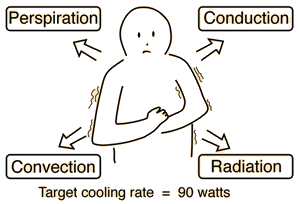Conduction Cooling of Body
  |
The basic heat transfer equation for conduction is  where in this case A would be the area of the human body and k the thermal conductivity of the air surrounding the body. A typical body area according to physiology texts: Thermal conductivity for still air:  Assuming a distance from the skin at which the temperature drops to the ambient temperature:  |
| Calculation with other model parameters |
| Discussion of the "wall thickness" assumption |
| Modeling the cooling of the human body |
Heat transfer concepts
Heat transfer examples
| HyperPhysics***** Thermodynamics | R Nave |
